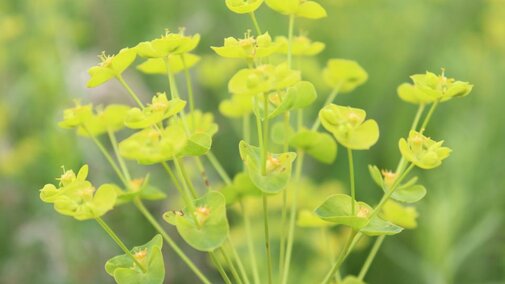Grazing Mixed Grass Pastures
Managing pastures that contain both cool- and warm-season grasses takes a bit of strategy, but done right, it can result in productive and healthy pastures across the grazing season.
Cool-season grasses like brome or fescue grow best in spring and fall, while warm-season grasses like big bluestem or switchgrass thrive in the summer heat. To get the most out of both, timing is everything.
Begin grazing in the spring on cool-season species, before warm-season grasses start growing (late May to early June). These plants are growing fast, have high quality, and are an earlier available forage resource than their warm-season counterparts. When summer hits, rotate into warm-season pastures and let cool-season grasses rest and recover for fall grazing. As long as moisture is available, some fall growth typically occurs.
Rotating the timing of grazing like this helps build healthy stands by limiting the grazing stress plants receive each year, especially if grazing during critical growing periods can be avoided.
But here’s the bonus — grazing timing can also be used to manage undesired species. If cool-season grasses are creeping into warm-season pastures, early grazing in the spring can stress those cool-season plants while warm-season grasses are still dormant. This allows you to knock back encroachment without hurting your desirable warm-season species.
With a well-timed rotation, mixed pastures can reduce hay needs, provide better forage quality, and help maintain a balanced plant community.
Grass Hay Harvest
Smooth bromegrass and other cool-season grass hay fields are growing rapidly, with seedheads beginning to appear. When do you typically cut your grass hay? Ideally, cutting your grass hay so the grass nutrient content matches with the nutritional needs of your livestock is best.
Crude protein and energy concentration declines in grass hay as plants become stemmy and mature. With smooth bromegrass for example, research has shown that crude protein content declines rapidly between boot and mature seed stages. Crude protein levels in well-fertilized hay harvested at early heading range from 10%–18% but drop rapidly after heading. Decreases in crude protein levels by as much as one-half percent per day after heading have been recorded.
Also keep in mind that plants tend to mature sooner when conditions are dry and temperatures are warmer than normal.
For Sandhills sub-irrigated meadows, haying typically starts in early July. However, if harvest occurs around the third week of June, then that hay will have significantly higher crude protein content. Earlier meadow harvest will have lower initial hay yield, but it will also provide a longer regrowth period and extra growth for fall grazing.
So, a good approach is to plan what type of livestock will receive the grass hay from each field. Young livestock need high nutrient concentrations, so cut that hay before or just when heads begin to emerge. If the hay will go to mature dry cows instead, let the grass produce a bit more tonnage and cut it after it is well headed out, but before seeds develop.
Matching your hay harvest with your plan of use can pay handsome dividends in lower costs and less supplementing.
Spring Weed Control: Leafy Spurge and Thistles
As pastures begin to green up, now is the time to scout pastures for two persistent problems — leafy spurge and non-native thistles like musk, plumeless and Canada thistle. Both are Nebraska noxious weeds, and early spring is the best opportunity for control.
Leafy spurge is a deep-rooted perennial with a yellow-green flower that shows up early in the season. Its root system can reach 15 feet deep, making it extremely difficult to control. Spring herbicide applications at the bud to early flower stage are most effective. Products like 2,4-D ester, Tordon 22K, Curtail, or a Plateau and Sharpen mix can reduce spurge growth and seed production. Just remember — one treatment won’t be enough. A follow-up fall application is often needed to catch regrowth and keep infestations from spreading.
Thistles, especially non-native species like musk and plumeless, should also be targeted in early spring. Look for plants in the rosette to bolting stage — that’s when herbicides work best. Top-rated products include Chaparral, Milestone and Opensight, with several other options depending on the specific species. Canada thistle, being a perennial, responds best to fall herbicide applications, but you can reduce spread now by mowing in June and July, and applying 2,4-D or a dicamba mix as a stopgap until fall. Just make sure to control before flowers occur.
Whichever weed you’re battling, control efforts need to start early and be followed up throughout the season. Our publication, EC-130 “Guide for Weed, Disease, and Insect Management in Nebraska” provides a list of recommended herbicide options and cost comparison of spurge, thistle and other noxious weed control products. Read and follow label directions, and don’t wait to control these weeds until they are flowering — by then, your options are limited, control is less effective, and next year’s seed is being spread.

